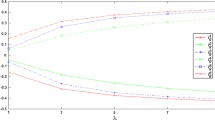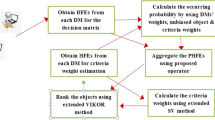Abstract
Due to the defects of hesitant fuzzy sets (HFSs) in the actual decision-making process, it is necessary to add the probabilities corresponding to decision maker’s preferences to the values in HFSs. Hesitant probabilistic fuzzy sets (HPFSs) are suitable for presenting this kind of information and contribute positively to the efficiency of depicting decision maker’s preferences in practice. However, some important issues in HPFSs utilization remain to be addressed. In this paper, the qualitative flexible multiple criteria method (QUALIFLEX) and the preference ranking organization method for enrichment evaluations II (PROMETHEE II) are extended to HPFSs. First, we provide a comparison method for hesitant probabilistic fuzzy elements (HPFEs). Second, we propose a novel possibility degree depicting the relations between two HPFEs, and then, employ the possibility degree to extend the QUALIFLEX and PROMETHEE II methods to hesitant probabilistic fuzzy environments based on the proposed possibility degree. Third, an information integration method is introduced to simplify the processing of HPFE evaluation information. Finally, we provide an example to demonstrate the usefulness of the proposed methods. An illustrative example in conjunction with comparative analyses is employed to demonstrate that our proposed methods are feasible for practical multi-criteria decision-making (MCDM) problems, and the final ranking results show that the proposed methods are more accurate than the compared methods in an actual decision-making processes. HPFSs are more practical than HFSs due to their efficiency in comprehensively representing uncertain, vague, and probabilistic information. The proposed methods are effective for solving hesitant probabilistic MCDM problems and are expected to contribute to the solution of MCDM problems involving uncertain or vague information.


Similar content being viewed by others
References
Liu Y, Vong CM, Wong PK. Extreme learning machine for huge hypotheses re-ranking in statistical machine translation. Cogn Comput. 2017;9(2):285–94.
Løkse S, Bianchi FM, Jenssen R. Training echo state networks with regularization through dimensionality reduction. Cogn Comput. 2017. doi:10.1007/s12559-017-9450-z.
Nian XH, Sun MP, Guo H, Wang HB, Dai LQ. Observer-based stabilization control of time-delay T-S fuzzy systems via the non-uniform delay partitioning approach. Cogn Comput. 2017;9(2):225–36.
Yao YY. Three-way decisions and cognitive computing. Cogn Comput. 2016;8(6):543–54.
Zhao HM, Ren JC. Cognitive computation of compressed sensing for watermark signal measurement. Cogn Comput. 2016;8(2):246–60.
Yu J, Rui Y, Tao DC. Click prediction for web image reranking using multimodal sparse coding. IEEE Transactions on Image Procession. 2014;25(3):2019–32.
Yu J, Yang XK, Gao F, Tao DC. Deep multimodal distance metric learning using click constraints for image ranking. IEEE Transactions on Cybernetics. 2016;PP(99):1–11. doi:10.1109/TCYB.2016.2591583.
Zhou Y, Zeng FZ, Zhao HM, Murray P, Ren JC. Hierarchical visual perception and two-dimensional compressive sensing for effective content-based color image retrieval. Cogn Comput. 2016;8(5):877–89.
Yu J, Zhang BP, Kuang ZZ, Lin D, Fan JP. Image privacy protection by identifying sensitive objects via deep multi-task learning. IEEE Transactions on Information Forensics and Security. 2017;12(5):1005–16. doi:10.1109/TIFS.2016.2636090.
Zhang J, Ding SF, Zhang N, Xue Y. Weight uncertainty in Boltzmann machine. Cogn Comput. 2016;8(6):1064–73.
Wang Q, Spratling MW. Contour detection in colour images using a neurophysiologically inspired model. Cogn Comput. 2016;8(6):1027–35.
Hong CQ, Yu J, Tao DC, Wang M. Image-based 3D human pose recovery by multi-view locality sensitive sparse retrieval. IEEE Trans Ind Electron. 2015;62(6):3742–51.
Hong CQ, Yu J, Wan J, Tao DC, Wang M. Multimodal deep autoencoder for human pose recovery. IEEE Trans Image Process. 2015;24(12):5659–70.
Meng FY, Wang C, Chen XH. Linguistic interval hesitant fuzzy sets and their application in decision making. Cogn Comput. 2016;8(1):52–68.
Farhadinia B, Xu ZS. Distance and aggregation-based methodologies for hesitant fuzzy decision making. Cogn Comput. 2017;9(1):81–94.
Zhao N, Xu ZS, Liu FJ. Group decision making with dual hesitant fuzzy preference relations. Cogn Comput. 2016;8(6):1119–43.
Liu PD, Tang GL. Multi-criteria group decision-making based on interval neutrosophic uncertain linguistic variables and choquet integral. Cogn Comput. 2016;8(6):1036–56.
Torra V. Hesitant fuzzy sets. International Journal of Intelligent System. 2010;25(6):529–39.
Peng J, Wang J, Wu X. Novel multi-criteria decision-making approaches based on hesitant fuzzy sets and Prospect theory. International Journal of Information Technology & Decision Making. 2016;15(3):621–43.
Xia MM, Xu ZS. Hesitant fuzzy information aggregation in decision making. Int J Approx Reason. 2011;52(3):395–407.
Farhadinia B. A series of score functions for hesitant fuzzy sets. Inf Sci. 2014;277(2):102–10.
Farhadinia B. Hesitant fuzzy sets lexicographical ordering and its application to multi-attribute decision making. Inf Sci. 2016;327(C):233–45.
Chen N, Xu ZS, Xia MM. Correlation coefficients of hesitant fuzzy sets and their applications to clustering analysis. Appl Math Model. 2013;37(4):2197–211.
Liao HC, Xu ZS, Zeng XJ. Novel correlation coefficients between hesitant fuzzy sets and their application in decision making. Knowl-Based Syst. 2015;82(C):115–27.
Farhadinia B. Information measures for hesitant fuzzy sets and interval-valued hesitant fuzzy sets. Inf Sci. 2013;240(10):129–44.
Bisht K, Kumar S. Fuzzy time series forecasting method based on hesitant fuzzy set. Expert Syst Appl. 2016;64(1):557–68.
Hu BD. Three-way decisions paces based on partially ordered sets and three-way decisions based on hesitant fuzzy sets. Knowl-Based Syst. 2016;91:16–31.
Rodríguez RM, Martínez L, Torra V, Xu ZS, Herrera F. Hesitant fuzzy sets: state of the art and future directions. Int J Intell Syst. 2014;29(6):495–524.
Rodríguez RM, Bedregal B, Bustince H, Dong YC, Farhadinia B, Kahraman C, Martínez L, Torra V, Xu ZS, Herrera F. A position and perspective analysis of hesitant fuzzy sets on information fusion in decision making. Towards high quality progress. Information Fusion. 2016;29(C):89–97.
Wei GW, Zhao XF, Lin R. Some hesitant interval-valued fuzzy aggregation operators and their applications to multiple attribute decision making. Knowl-Based Syst. 2013;46(4):43–53.
Zhu B, Xu ZS, Xia MM. Dual hesitant fuzzy set. J Appl Math. 2012;11:2607–45.
Hu JH, Xiao KL, Chen XH, Liu YM. Interval type-2 hesitant fuzzy set and its application in multi-criteria decision making. Comput Ind Eng. 2015;87:91–103.
Lin R, Zhao XF, Wei GW. Model for selecting an ERP system with hesitant fuzzy linguistic information. Journal of intelligent & Fuzzy Systems Application. 2014;26(5):2155–65.
Bedregal B, Beliakov G, Bustince H, Calvo T, Mesiar R, Paternain D. A class of fuzzy multisets with a fixed number of memberships. Inf Sci. 2012;189(6):1–17.
Bustince H, Barrenechea E, Pagola M, Fernandez J, Xu ZS, Bedregal B, et al. A historical account of types of fuzzy sets and their relationships. IEEE Trans Fuzzy Syst. 2016;24(1):179–94.
Zhang S, Xu ZS, He Y. Operations and integrations of probabilistic hesitant fuzzy information in decision making. Information Fusion. 2017;38:1–11. doi:10.1016/j.inffus.2017.02.001.
Xu ZS, Zhou W. Consensus building with a group of decision makers under the hesitant probabilistic fuzzy environment. Fuzzy Optim Decis Making. 2016. doi:10.1007/s10700-016-9257-5.
Chen TY. Multiple criteria decision analysis using a likelihood-based outranking method based on interval-valued intuitionistic fuzzy sets. Inf Sci. 2014;286(1):188–208.
Ji P, Zhang H, Wang J. A projection-based TODIM method under multi-valued neutrosophic environments and its application in personnel selection. Neural Comput & Applic. 2016. doi:10.1007/s00521-016-2436-z.
Yu SM, Wang J, Wang JQ. An extended TODIM approach with intuitionistic linguistic number. Int Trans Oper Res. 2016. doi:10.1111/itor.12363.
Zhang XL. Multicriteria Pythagorean fuzzy decision analysis: a hierarchical QUALIFLEX approach with the closeness index-based ranking method. Inf Sci. 2016;330(10):104–24.
W JC, Tsao TY, Chen TY. A likelihood-based QUALIFLEX method with interval type-2 fuzzy sets for multiple criteria decision analysis. Soft Comput. 2015;19(8):2225–43.
Yu SM, Wang J, Wang JQ. An interval type-2 fuzzy likelihood-based MABAC approach and its application in selecting hotels on the tourism website. International Journal of Fuzzy Systems. 2017;19(1):47–61.
Tian ZP, Wang J, Wang JQ, Zhang HY. A likelihood-based qualitative flexible approach with hesitant fuzzy linguistic information. Cognitive Computing. 2016;8(4):670–83.
Chen TY. Interval-valued intuitionistic fuzzy QUALIFLEX method with a likelihood-based comparison approach for multiple criteria decision analysis. Inf Sci. 2014;261(10):149–69.
Peng JJ, Wang JQ, Yang WE. A multi-valued neutrosophic qualitative flexible approach based on likelihood for multi-criteria decision-making problems. Int J Syst Sci. 2017;48(2):425–35.
Peng JJ, Wang JQ, Wu XH. An extension of the ELECTRE approach with multi-valued neutrosophic information. Neural Comput & Applic. 2016. doi:10.1007/s00521-016-2411-8.
Wan SP, Xu GL, Dong JY. Supplier selection using ANP and ELECTRE II in interval 2-tuple linguistic environment. Inf Sci. 2017;385-386(S):19–38.
Chen TY. An interval type-2 fuzzy PROMETHEE method using a likelihood-based outranking comparison approach. Information Fusion. 2015;25(C):105–20.
Zhou H, Wang J, Zhang H. Stochastic multicriteria decision-making approach based on SMAA-ELECTRE with extended gray numbers. Int Trans Oper Res. 2017. doi:10.1111/itor.12380.
Wang JQ, Kuang JJ, Wang J, Zhang HY. An extended outranking approach to rough stochastic multi-criteria decision-making problems. Cogn Comput. 2016;8(6):1144–60.
Kuang H, Kilgour DM, Hipel DW. Grey-based PROMETHEE II with application to evaluation of source water protection strategies. Inf Sci. 2015;294(10):376–89.
Boujelben MA. A unicriterion analysis based on the PROMETHEE principles for multicriteria ordered clustering. Omega. 2017;69:126–40.
Corrente S, Figueira JR, Greco S. The SMAA-PROMETHEE method. Eur J Oper Res. 2014;239(2):514–22.
Wang J, Wang JQ, Zhang HY. A likelihood-based TODIM approach based on multi-hesitant fuzzy linguistic information for evaluation in logistics outsourcing. Comput Ind Eng. 2016;99(C):287–99.
Acknowledgements
The authors thank the editors and anonymous reviewers for their helpful comments and suggestions. This work was supported by the National Natural Science Foundation of China (No. 71571193).
Author information
Authors and Affiliations
Corresponding author
Ethics declarations
Conflict of Interest
The authors declare that they have no conflict of interest.
Informed Consent
Informed consent was not required as no humans or animals were involved.
Human and Animal Rights
This article does not contain any studies with human or animal subjects performed by any of the authors.
Appendices
Appendix 1
Appendix 2. Proof of Property 1
Proof
(1) can be easily obtained, and is omitted here.
Since (2), (3), and (4) are similar, we choose (4) to prove. If h(p x ) < h(p y ), then according to Definition 9, we obtain \( {\gamma}_x^{\sigma (j)}\le {\gamma}_y^{\sigma (j)} \) (j = 1, 2, ⋯ , l; l = min {m, n}), where at least one of the “≤” relations should be “<.” In the following, we will show the proof in two different conditions:
-
Case 1:
m = n
-
Case 2:
m < n
A similar proof can be obtained when m > n.
The details of proofs (5) and (6) are omitted to save space.
This completes the proof.
Rights and permissions
About this article
Cite this article
Li, J., Wang, Jq. Multi-criteria Outranking Methods with Hesitant Probabilistic Fuzzy Sets. Cogn Comput 9, 611–625 (2017). https://doi.org/10.1007/s12559-017-9476-2
Received:
Accepted:
Published:
Issue Date:
DOI: https://doi.org/10.1007/s12559-017-9476-2




